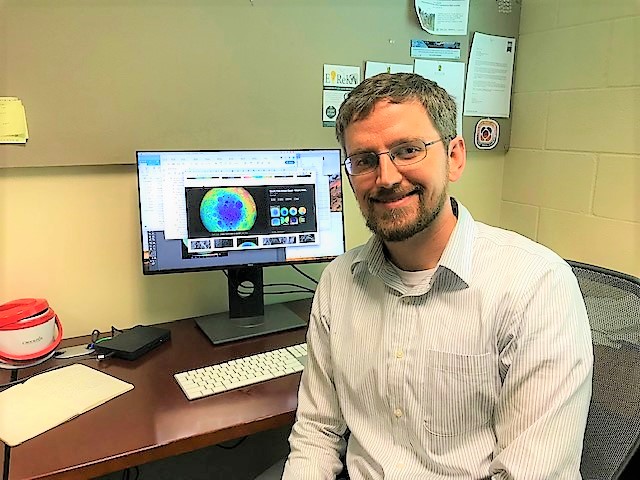Mass Anomaly Detected Under the Moon’s Largest Crater


Discovery may contain metal from asteroid crash, Baylor University researcher says
Media Contact: Terry Goodrich, 254-710-3321
Follow Baylor Media Communications on Twitter: @BaylorUMedia
WACO, Texas (June 10, 2019) — A mysterious large mass of material has been discovered beneath the largest crater in our solar system — the Moon’s South Pole-Aitken basin — and may contain metal from an asteroid that crashed into the Moon and formed the crater, according to a Baylor University study.
“Imagine taking a pile of metal five times larger than the Big Island of Hawaii and burying it underground. That’s roughly how much unexpected mass we detected,” said lead author Peter B. James, Ph.D., assistant professor of planetary geophysics in Baylor’s College of Arts & Sciences.
The crater itself is oval-shaped, as wide as 2,000 kilometers — roughly the distance between Waco, Texas, and Washington, D.C. — and several miles deep. Despite its size, it cannot be seen from Earth because it is on the far side of the Moon.
The study — ”Deep Structure of the Lunar South Pole-Aitken Basin” — is published in the journal Geophysical Research Letters.
To measure subtle changes in the strength of gravity around the Moon, researchers analyzed data from spacecrafts used for the National Aeronautics and Space Administration (NASA) Gravity Recovery and Interior Laboratory (GRAIL) mission.
“When we combined that with lunar topography data from the Lunar Reconnaissance Orbiter, we discovered the unexpectedly large amount of mass hundreds of miles underneath the South Pole-Aitken basin,” James said. “One of the explanations of this extra mass is that the metal from the asteroid that formed this crater is still embedded in the Moon’s mantle.”
The dense mass — “whatever it is, wherever it came from” — is weighing the basin floor downward by more than half a mile, he said. Computer simulations of large asteroid impacts suggest that, under the right conditions, an iron-nickel core of an asteroid may be dispersed into the upper mantle (the layer between the Moon’s crust and core) during an impact.
“We did the math and showed that a sufficiently dispersed core of the asteroid that made the impact could remain suspended in the Moon’s mantle until the present day, rather than sinking to the Moon’s core,” James said.
Another possibility is that the large mass might be a concentration of dense oxides associated with the last stage of lunar magma ocean solidification.
James said that the South Pole-Aitken basin — thought to have been created about 4 billion years ago — is the largest preserved crater in the solar system. While larger impacts may have occurred throughout the solar system, including on Earth, most traces of those have been lost.
James called the basin “one of the best natural laboratories for studying catastrophic impact events, an ancient process that shaped all of the rocky planets and moons we see today.”
*This research was supported through the NASA Gravity Recovery and Interior Laboratory (GRAIL) science team.
Co-researchers were David E. Smith, Ph.D., principal investigator for the Lunar Orbiter Laser Altimeter onboard the Lunar Reconnaissance Orbiter; Paul K. Byrne, Ph.D., North Carolina State University; Jordan D. Kendall, Ph.D., Goddard Space Flight Center; H. Jay Melosh, Ph.D., Purdue University; and Maria T. Zuber, Ph.D., GRAIL principal investigator.
ABOUT PETER B. JAMES
Peter B. James, Ph.D., served on the science team of three NASA missions: the Lunar Reconnaissance Orbiter (LRO), the Gravity Recovery and Interior Laboratory (GRAIL), and the MErcury Surface, Space ENvironment, GEochemistry, and Ranging (MESSENGER) mission. He is the founder of Baylor University’s Planetary Research Group, which is currently collaborating with Goddard Space Flight Center to study the properties of Mercury's crust and lithosphere. Dr. James specializes in the use of spacecraft data to study the crusts and mantles of planets and moons in our solar system. He earned his Ph.D. from the Massachusetts Institute of Technology.
ABOUT BAYLOR UNIVERSITY
Baylor University is a private Christian University and a nationally ranked research institution. The University provides a vibrant campus community for more than 17,000 students by blending interdisciplinary research with an international reputation for educational excellence and a faculty commitment to teaching and scholarship. Chartered in 1845 by the Republic of Texas through the efforts of Baptist pioneers, Baylor is the oldest continually operating University in Texas. Located in Waco, Baylor welcomes students from all 50 states and more than 90 countries to study a broad range of degrees among its 12 nationally recognized academic divisions.
ABOUT THE COLLEGE OF ARTS & SCIENCES AT BAYLOR UNIVERSITY
The College of Arts & Sciences is Baylor University’s oldest and largest academic division, consisting of 25 academic departments and seven academic centers and institutes. The more than 5,000 courses taught in the College span topics from art and theatre to religion, philosophy, sociology and the natural sciences. Faculty conduct research around the world, and research on the undergraduate and graduate level is prevalent throughout all disciplines. Visit www.baylor.edu/artsandsciences.